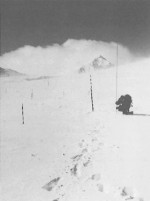The Niwot Ridge LTER site has begun winter snowpack and ground-temperature observations as part of baseline studies for a snowpack-alteration experiment. The experiment will help determine the long-term ecological effects of altered snow-regimes that are expected to occur in alpine regions as a consequence of climate change. Previous studies of altered snowpack have been short term (four years or less) and examined only the effects to the above- ground vegetation. This study is designed as a >100-year experiment and will look at the aboveground and below-ground ecosystems. An interesting aspect of the manipulation will be the effect on gophers. Snowpatch sites are normally areas of gopher activity because of relatively warm subnivean temperatures.
Most of the experimental area is currently free of gophers because of shallow winter snow conditions and frozen soils that prevent gopher digging. To separate the effects of gophers from the direct effects of increased snowpack, we will exclude gophers from a portion of the experimental area.
A specially designed snow fence will be constructed in the summer of 1993. The fence will be 60 m long and 2.6 m tall and create a leeward drift 60 x 70 m and 3 m deep. A windward drift will be half as large. The fence will be built along an ecotone between a dry sedge meadow and a moist forb community. An area with low willows will also be impacted by the windward drift. The fence is an ideal manipulation experiment because it is relatively easy to maintain and should create a gradient of increased and decreased snowpack downwind of the fence. It will have to be removed each spring to ensure that summer wind regimes and evapotranspiration rates are not also altered in the area.
During winter, there is no access to the Niwot Ridge Saddle by vehicles, so researchers ski 7 km from the Mountain Research Station climbing 750 m to the site and skiing back down. (Powder conditions are a prerequisite for selecting days for observations). Snow depth is monitored at 88 grid points on the 350 x 500-rn Saddle Grid, and 142 points on a 60 x 125-m grid that will be impacted by the snow-fence drifts. Soil temperatures are monitored at 14 sites along a transect upwind and downwind of the fence.
The following were some of the interesting results of the first winter’s observations:
- Early-winter accumulation of snow on the site is controlled by microtopography and taller vegetation. The willows trapped up to 50 cm of snow during November and December. Later in the winter snow drifts caused by mesoropographic features, such as the 100-rn west knoll of the Saddle, overwhelmed the smaller drifts. The timing of drift development has important implications for soil temperatures. If drifts develop late in the season, soil temperatures are likely to be much colder than in sites that develop drifts in early winter.
- Although temperatures are consistently below freezing all winter, the snowpack over most of the study area is periodically deflated due to strong winds that regularly follow storm events. This cyclic pattern of accumulation and deflation can cause unusual patterns of soil surface temperatures. Temperatures in the rooting zone (15-cm depth), however, are more predict able: cooling in late January to about -10 °C in the wind-blown dry sedge meadow and about -5 °C in the willows.
- The winter of 1992-93 was unusually wet. April was the wettest month ever recorded at D-1 (271 mm of precipitation), and the period November to April was 183% above the 195 1-85 mean for the same period. Many areas that are normally free of snow all winter were snow covered, providing some indication of the snowpack patterns that could be expected if precipitation increases in the alpine due to climate change.
For more information: Skip Walker; INSTAAR, University of Colorado, Boulder CO 80309-0450, 303-492-7303, swalker@LTERnet.edu.

 Enlarge this image
Enlarge this image